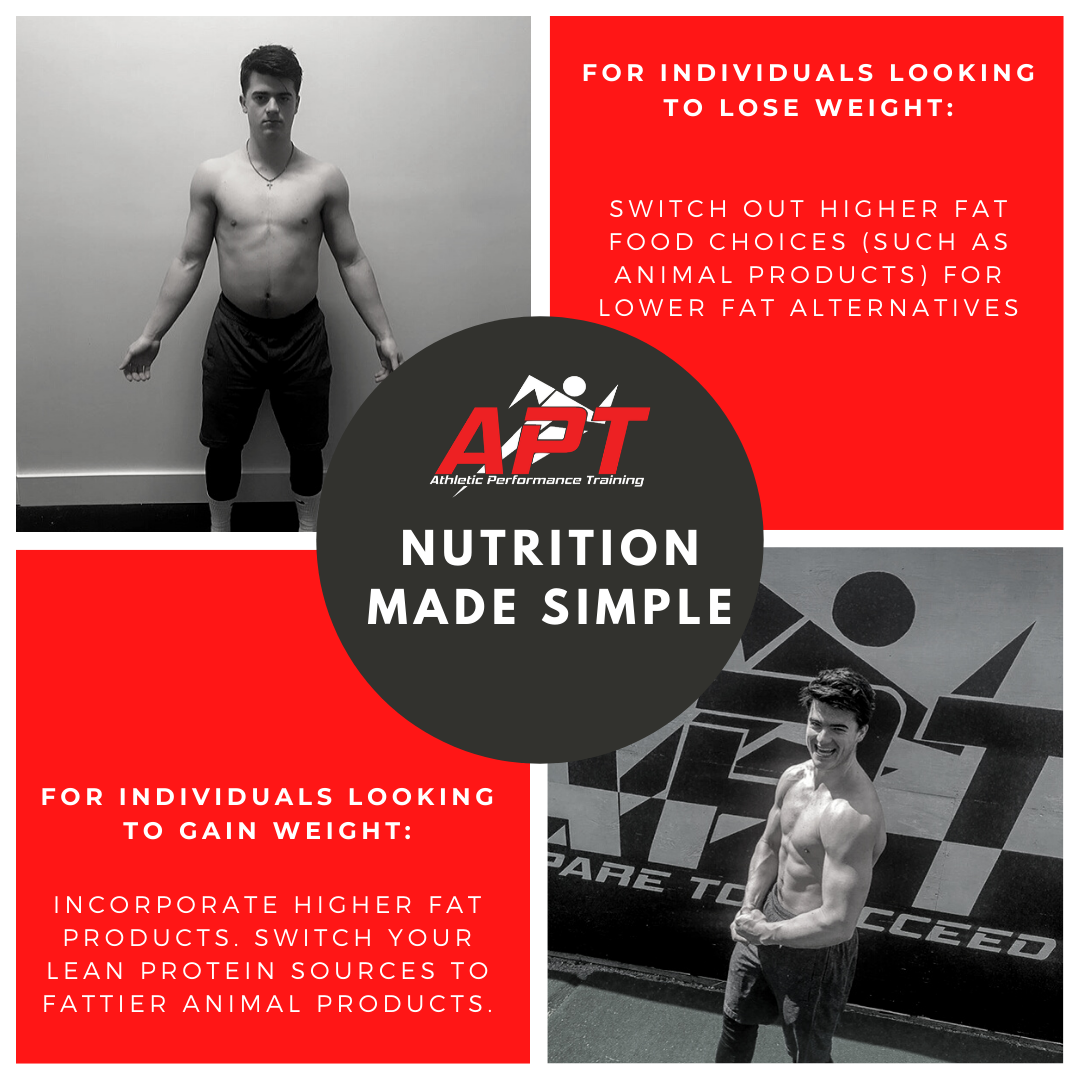Nutrition made simple

Nutrition made simple
There are many rabbit holes that you can dive down when talking about nutrition, but the core principles when it comes to habit change almost always come back to calories. First and foremost, we need to address that an adult trainee is going to have vastly different nutritional recommendations than an athlete. In most cases, adults are more sedentary outside of their few hours of gym sessions a week compared to athletes who are training on top of practices & games. For the purpose of this post, we will stick to calories as our main topic of discussion.
Calories are the energy we receive from eating food. As you perform daily tasks or physical activities your body will use up this energy in order to fuel whatever the task at hand. Don’t confuse calories as only being used up during purposeful activity either; simply sitting at the desk tapping your finger can burn calories, as can the mental focus/brain function you are applying to your work. Most individuals that are done growing and have a pretty consistent daily schedule will find themselves at a set point in terms of bodyweight. This settling point is where your body typically likes to sit based off the calories you supply it with, and the amount of activity you perform. We can also refer to this as maintenance, where you are consistently getting the energy demands your body requires to keep a stable bodyweight. In addition to maintenance, you can also have a surplus (referring to when you are consuming more calories than needed to match energy demands) or a deficit (which refers to when you are not meeting your daily calorie needs). Ultimately, if you are consuming more calories than you are using through daily activity you will gain weight. On the other hand, if you are consuming less calories than you are using you will begin to break down some of your own tissue resulting in weight loss.
[Just to clarify, there are a lot of different terms that are used interchangeably. Surplus, gaining, bulking, and hypercaloric all refer to the act of increasing calorie intake to result in weight gain. Deficit, cutting, hypocaloric all refer to decreasing calorie intake to result in weight loss.]
Given these definitions, the process of achieving a surplus or deficit is left considerably open ended. In other words, there are a variety of approaches you can use to get to your desired outcome. With the influence that social media has on our society nowadays, it’s easy to get wrapped up in the fad diets such as keto, low-carb, Whole 30, intermittent fasting, paleo, and think that they are the only approach to losing weight. However none of the aforementioned approaches are better than the other, each one simply is a different way to create a calorie deficit, whether it's through eliminating certain foods or times in which you can eat.
Because the act of manipulating body weight always comes back to calories, the initial thought is typically to begin tracking calories so that you can manage the outcome. I would agree, however I understand that different individuals have different circumstances and it may not be reasonable to assume that everyone will be able to track their intake. For those individuals I can offer a few guidelines below that may begin leading them down the path they desire. What I will say is that trying to manipulate your diet through habitual changes alone could be the equivalent of driving a car without a speedometer. You can probably guage things pretty well and get away with it for a while, but you’ll never truly know what speed you’re going at. If body composition changes are truly your top priority, then sacrifices such as weighing out food and tracking calories shouldn't stop you. With that being said, if habit changes are where you want to get started, take a look at the suggestions below.
For individuals looking to lose weight:
1.Switch out higher fat food choices (such as animal products) for lower fat alternatives
2.Switch out any calorie containing condiments like ketchup, mayo, etc for non-calorie containing condiments such as hot sauces, seasonings, etc. Nowadays you can probably find almost any condiment in a zero or low calorie version
3.Avoid eating out or picking up food at restaurants/shops as much as possible, as they will almost always contain some sort of house dressing that is very fatty.
Choose higher volume foods. For example a full plate of vegetables will be a lot of chewing and eating for fewer calories. Plus the higher fiber content will help with satiety as well.
4.Be honest with yourself about snacking, if you think taking a bite of your child's/wives/husbands lunch while you make it everyday doesn’t add up, you’re fooling yourself.
5.Reduce consumption of any liquids containing calories, it’s very easy to drink hundreds of calories during the day without feeling any satiety from them
Utilize caffeine's hunger-reducing effects. A cup of coffee or two in the morning will decrease your hunger.
For individuals looking to gain weight:
1.Incorporate higher fat products. Switch your lean protein sources to fattier animal products.
2.Consume more calorie dense food items (foods that are higher volume or fiber will fill you up more and provide you with fewer calories at this time, so opt for the calorie dense low-fiber options instead).
3.Consume more calorie containing liquids. Milks, juices, etc. will be your friend at this time.
4.Utilize screen time while eating. If you’re watching TV or scrolling through your phone while eating, you’re likely to consume more than if you were just sitting down focused on your meal.
5.When snacking, don’t bother to use a dish. If you eat directly from the package you may be opt to consume a bit more.
